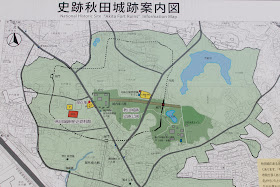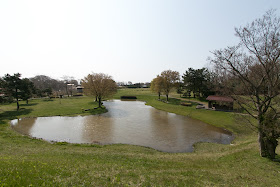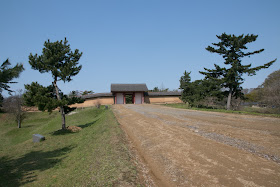Akita Castle
-Left part of twin strikers of ancient Yamato dynasty-
Overview
Name: Akita castle (Akita-jo)
Alias:
Place: Terauchi Akita city, Akita
Location: 39.740587007153735, 140.07940834097204
Type: Ancient Castle
Built: 733
Remaining remnants: Clay walls
Title: 100 more famous Japanese castles
Akita castle (秋田城, to make sure, large castle at the center of Akita city is named as Kubota castle) is built over the western half of plateau which is about 30 meter height and has a size of 1 kilometer long and 500 meter wide, at the mouth of old Omono-gawa river. Omono-gawa river is a large river which forms Yokote basin at upper stream and Akita plain at downstream, and good connecting path between inland area and the Sea of Japan.
Tsuchizaki port which existed at the north west of Akita castle was originally built as a supply port of Akita castle, but later prospered by marine transportation and became one of 10 major port of medieval era. Even now Akita port renamed from Tsuchizaki port has large size peers and works as a important place of marine transportation at the Sea of Japan both for cargo and passengers.
It is recorded that Akita castle was built in 733, as a movement of Dewa fort which originally existed at current Shonai area of Yamagata prefecture. Originally north border of Yamato dynasty was around current Niigata prefecture and Tochigi prefecture, which were the territory of ancient countries such as Koshi or Kenu. The power of Yamato dynasty did not reach ahead of this border, and there were the world of another culture.
Since the middle of 7th century, just after the Taika no Kaishin occurred in 645, a political reform performed by Emperor Tenchi (626-672), Yamato dynasty started to expand northward, not only from domestic reason but also an international circumstance.
Around this time the alliance of Chinese Tang dynasty and Korean Sila kingdom suppressed Baekje kingdom allied with Yamato dynasty, then Yamato dynasty had to prepare for a detour attack from passing north edge of Sea of Japan, in addition to the front side attack from Tsushima straight.
As current Tohoku region is separated to Pacific Ocean side and Sea of Japan side by Oshu mountain, Yamato dynasty made operation in two front. Sea of Japan side preceded to Pacific Ocean side, as it was necessary to grasp coast area and secure the border along Sea of Japan. At first in 647 and 648, Yamato dynasty built two forts named Nutari fort and Iwafune fort at current Niigata prefecture.
Succeeding to this, Hirafu Abe (?-?), a general of Yamato dynasty and governor of Koshi province, made expedition with his fleet along the Sea of Japan toward current Hokkaido, then broke local lords and appointed local supporters as magistrates. Of course this domination did not continue long, but Yamato dynasty grasped situation of northern area.
Just after this Yamato dynasty had to cope with international crisis occurred from the fall of Baekje kingdom and defeat at the naval battle of Baekgang, and its activity at northern border once stopped. But after 50 years that, once international situation stabilized, expansion at north border resumed. The dynasty built many forts as a military camp and evacuation place of settlers in case of emergency.
In 712, Dewa province was newly established dividing from Echigo province, to make clear as a front line toward north along with Mutsu province at Pacific Ocean side. At the same time, Dewa fort which was a military and administrative base of the province was built around current Shonai area. Also current Yamagata area was attached to Dewa province, as a hinterland connected to Mutsu province.
In the former half of 8th century, Yamato dynasty rapidly pushed up its front line toward north like combination of twin strikers. At Pacific Ocean side, Tagajo castle (Miyagi prefecture) which was a vice capital of dynasty at northern area was built at the north of current Sendai city in 724, furthermore Korehari fort or Monou fort were constructed at further northern area.
Contrary to this, at Sea of Japan side, Dewa fort was moved to the current place in 733 by Azubabito Ono (?-742), the highest general of Yamato dynasty at Tohoku region. Azumabito also built a connecting route between Pacific Ocean side and Sea of Japan side passing Yokote basin, and built Okatsu castle to protect this route.
Dewa fort was positioned as a center of Sea of Japan side, corresponding to Tagajo castle at Pacific Ocean side. At this point Akita castle was exactly the north border of Yamato dynasty. After several reform and expansion, Dewa fort was renamed to Akita castle in 760, to show its importance.
The shape of Akita castle is roughly a 600 meter square with a lack of northwestern corner, affected by its terrain. At the center of this castle there was a central area of about 100 meter square, which had buildings such as main hole, sub hole and attached storages built in the same manner as the capital.
Outside of this central area, there were many building used as administrative offices, military camps or storages all over the area. Administrative documents or parts of armor were actually found by excavation. Outer area is securely protected by natural cliffs and clay walls, and prominent front side gates which had red pillars and roofed with blocks were built at the middle of eastern line and western line, along with broad connecting roads.
In addition to administrative and military role, Akita castle also held diplomatic role. At this time Balhae kingdom existed at northeastern border of current China sent envoy to ally with Japan to cope with Sila kingdom and Tang dynasty. In 727 first envoy arrived at Dewa province, and this might be one reason of the movement of Dewa fort. Outside of the castle there is a ruin of the lodges for envoys, and although there is no record, envoys might stay at Akita castle.
However, expansion of Yamato dynasty brought antipathy of local people, thus rebellions of local people frequently occurred in the latter half of 8th century. At Pacific Ocean side even Tagajo castle which was the vice capital of dynasty was once lost at the rebel of Azamaro Korehari (?-?), and it took time and effort to stabilize the situation. Finally Tamuramaro Sakanoue (758-811), nominated as Shogun for the first time, broke rebel and proceeded into current Miyagi prefecture.
Contrary to Pacific Ocean side, Sea of Japan side keep stabilized, but heavy earthquakes in the former half of 9th century and bad harvests gradually grew the antipathy of local people. In 878, local people finally rebelled and captured Akita castle, and commander of Akita castle escaped from castle. Central government sent reinforcement army to vacant Akita castle, but this army suffered severe defeat by local army.
At this point Yasunori Fujiwara (825-895) who was known as a good governor was appointed as the commander of Akita castle. Yasunori delivered foods reserves to residents and mitigated antipathy and ceased this rebellion. After the battle Yasunori reconstructed Akita castle with securer walls, but Akita castle ceased its operation by the middle of 10th century.
Today major part of castle became ground of shrines or houses, but most part of central area and connecting road toward east gate became historical park. Fences and gates were partially reconstructed, along with the ruin of water restroom faces march outside of the gate. Compared with other ancient castles such as Tagajo castle or Onojo castle remaining ruins is limited, but various kind of discoveries and blue sea slightly seen from the edge of the castle shows importance and role of Akita castle in ancient Japan.
30 minutes walk from JR East Ou-Honsen line Tsuchizaki station. 20 minutes bus ride from JR East Ou-Honsen line/Akita Shinkansen line Akita station. 15 minutes drive from Akita Jidoshado Expressway Akita-Kita interchange.
Kubota Castle -Distinguished clan which survived turbulent period-
Tagajo Castle -Vice capital of ancient Japan in fortress city-
Type: Ancient Castle
Built: 733
Remaining remnants: Clay walls
Title: 100 more famous Japanese castles
Brief History
Akita castle (秋田城, to make sure, large castle at the center of Akita city is named as Kubota castle) is built over the western half of plateau which is about 30 meter height and has a size of 1 kilometer long and 500 meter wide, at the mouth of old Omono-gawa river. Omono-gawa river is a large river which forms Yokote basin at upper stream and Akita plain at downstream, and good connecting path between inland area and the Sea of Japan.
Tsuchizaki port which existed at the north west of Akita castle was originally built as a supply port of Akita castle, but later prospered by marine transportation and became one of 10 major port of medieval era. Even now Akita port renamed from Tsuchizaki port has large size peers and works as a important place of marine transportation at the Sea of Japan both for cargo and passengers.
Northern area in ancient period
It is recorded that Akita castle was built in 733, as a movement of Dewa fort which originally existed at current Shonai area of Yamagata prefecture. Originally north border of Yamato dynasty was around current Niigata prefecture and Tochigi prefecture, which were the territory of ancient countries such as Koshi or Kenu. The power of Yamato dynasty did not reach ahead of this border, and there were the world of another culture.
Since the middle of 7th century, just after the Taika no Kaishin occurred in 645, a political reform performed by Emperor Tenchi (626-672), Yamato dynasty started to expand northward, not only from domestic reason but also an international circumstance.
Around this time the alliance of Chinese Tang dynasty and Korean Sila kingdom suppressed Baekje kingdom allied with Yamato dynasty, then Yamato dynasty had to prepare for a detour attack from passing north edge of Sea of Japan, in addition to the front side attack from Tsushima straight.
Expansion of Yamato dynasty
As current Tohoku region is separated to Pacific Ocean side and Sea of Japan side by Oshu mountain, Yamato dynasty made operation in two front. Sea of Japan side preceded to Pacific Ocean side, as it was necessary to grasp coast area and secure the border along Sea of Japan. At first in 647 and 648, Yamato dynasty built two forts named Nutari fort and Iwafune fort at current Niigata prefecture.
Succeeding to this, Hirafu Abe (?-?), a general of Yamato dynasty and governor of Koshi province, made expedition with his fleet along the Sea of Japan toward current Hokkaido, then broke local lords and appointed local supporters as magistrates. Of course this domination did not continue long, but Yamato dynasty grasped situation of northern area.
Just after this Yamato dynasty had to cope with international crisis occurred from the fall of Baekje kingdom and defeat at the naval battle of Baekgang, and its activity at northern border once stopped. But after 50 years that, once international situation stabilized, expansion at north border resumed. The dynasty built many forts as a military camp and evacuation place of settlers in case of emergency.
Build of Akita castle
In 712, Dewa province was newly established dividing from Echigo province, to make clear as a front line toward north along with Mutsu province at Pacific Ocean side. At the same time, Dewa fort which was a military and administrative base of the province was built around current Shonai area. Also current Yamagata area was attached to Dewa province, as a hinterland connected to Mutsu province.
In the former half of 8th century, Yamato dynasty rapidly pushed up its front line toward north like combination of twin strikers. At Pacific Ocean side, Tagajo castle (Miyagi prefecture) which was a vice capital of dynasty at northern area was built at the north of current Sendai city in 724, furthermore Korehari fort or Monou fort were constructed at further northern area.
Contrary to this, at Sea of Japan side, Dewa fort was moved to the current place in 733 by Azubabito Ono (?-742), the highest general of Yamato dynasty at Tohoku region. Azumabito also built a connecting route between Pacific Ocean side and Sea of Japan side passing Yokote basin, and built Okatsu castle to protect this route.
Dewa fort was positioned as a center of Sea of Japan side, corresponding to Tagajo castle at Pacific Ocean side. At this point Akita castle was exactly the north border of Yamato dynasty. After several reform and expansion, Dewa fort was renamed to Akita castle in 760, to show its importance.
Structure of Akita castle
The shape of Akita castle is roughly a 600 meter square with a lack of northwestern corner, affected by its terrain. At the center of this castle there was a central area of about 100 meter square, which had buildings such as main hole, sub hole and attached storages built in the same manner as the capital.
Outside of this central area, there were many building used as administrative offices, military camps or storages all over the area. Administrative documents or parts of armor were actually found by excavation. Outer area is securely protected by natural cliffs and clay walls, and prominent front side gates which had red pillars and roofed with blocks were built at the middle of eastern line and western line, along with broad connecting roads.
In addition to administrative and military role, Akita castle also held diplomatic role. At this time Balhae kingdom existed at northeastern border of current China sent envoy to ally with Japan to cope with Sila kingdom and Tang dynasty. In 727 first envoy arrived at Dewa province, and this might be one reason of the movement of Dewa fort. Outside of the castle there is a ruin of the lodges for envoys, and although there is no record, envoys might stay at Akita castle.
Turbulence and afterward
However, expansion of Yamato dynasty brought antipathy of local people, thus rebellions of local people frequently occurred in the latter half of 8th century. At Pacific Ocean side even Tagajo castle which was the vice capital of dynasty was once lost at the rebel of Azamaro Korehari (?-?), and it took time and effort to stabilize the situation. Finally Tamuramaro Sakanoue (758-811), nominated as Shogun for the first time, broke rebel and proceeded into current Miyagi prefecture.
Contrary to Pacific Ocean side, Sea of Japan side keep stabilized, but heavy earthquakes in the former half of 9th century and bad harvests gradually grew the antipathy of local people. In 878, local people finally rebelled and captured Akita castle, and commander of Akita castle escaped from castle. Central government sent reinforcement army to vacant Akita castle, but this army suffered severe defeat by local army.
At this point Yasunori Fujiwara (825-895) who was known as a good governor was appointed as the commander of Akita castle. Yasunori delivered foods reserves to residents and mitigated antipathy and ceased this rebellion. After the battle Yasunori reconstructed Akita castle with securer walls, but Akita castle ceased its operation by the middle of 10th century.
Today major part of castle became ground of shrines or houses, but most part of central area and connecting road toward east gate became historical park. Fences and gates were partially reconstructed, along with the ruin of water restroom faces march outside of the gate. Compared with other ancient castles such as Tagajo castle or Onojo castle remaining ruins is limited, but various kind of discoveries and blue sea slightly seen from the edge of the castle shows importance and role of Akita castle in ancient Japan.
Access
30 minutes walk from JR East Ou-Honsen line Tsuchizaki station. 20 minutes bus ride from JR East Ou-Honsen line/Akita Shinkansen line Akita station. 15 minutes drive from Akita Jidoshado Expressway Akita-Kita interchange.
Related Castles
Kubota Castle -Distinguished clan which survived turbulent period-
Tagajo Castle -Vice capital of ancient Japan in fortress city-




















































































































No comments:
Post a Comment